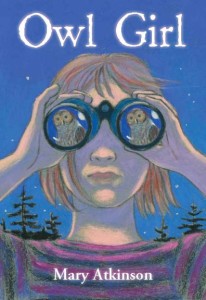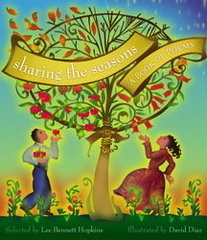It’s a pleasure to welcome Mary Atkinson back to ReaderKidZ to talk about her new book, OWL GIRL .
Dianne: Learning to deal with change and managing the sometimes-rocky transitions of childhood are important themes in children’s literature. I love the world you’ve created in OWL GIRL. Gram and Gramps’s house on Padgett Lake feels safe and yet things aren’t working out the way Holly had hoped. There’s real tension between her and Gram and readers empathize with the unsettled feelings Holly faces, not only in her day-to-day interactions with Gram, but also as she deals with the uncertainty of the future of her parents’ marriage.
What drew you to this particular subject and what were some of the challenges of fleshing out the story?
MARY: Nature has always been a hugely important part of my life. Ever since I was a little girl, I’ve enjoyed going on long solitary walks in the woods or on a beach. (In childhood, I had my imaginary friends with me. 🙂 In good times and in troubled times, nature has always been there for me. It’s my place to find balance, solace and meaning. I’m expecting it will be for Holly, too, as she grows up and encounters more of those “rocky transitions.”
Maintaining a level of escalating tension–you know, that old plot problem–was a challenge for me in OWL GIRL so I’m glad you felt it as you read Holly’s story!
Dianne: Holly’s at a tender age. Not quite old enough to do all the things she’d like to do. But not quite the “baby” of the family, either. You cover a lot of emotional territory and deepen that territory by coming at it from different angles. Each thread of Holly’s story seems carefully woven, one around the other, to create a compact, richly resonant novel. Can you talk about the process of writing this novel and the decisions you made along the way?
MARY: Thank you, Dianne! This novel went through a lot of revisions (as they all do). I wanted to keep it simple and focused on Holly’s experience, carefully weaving together the threads that contributed to her emotional growth. Luckily, I love color-coded charts and diagrams! After the first drafts, my charts showed me that I had too many threads that interfered with the emotional focus I wanted to maintain, so they had to go.
Dianne: It’s obvious you called upon your tools as a poet to write OWL GIRL. What role does poetry and your poet’s toolbox play when you decide to tell a story in prose?
MARY: OWL GIRL started out as a series of poems! I originally envisioned it as a verse novel for young readers, but in the end I wasn’t satisfied. The story kept wanting to burst out into prose. As a prose writer, I’m very aware of sentence length, the spaces and energy between sentences and between paragraphs, word choice and what words sound good together (I always read aloud for musicality and flow), and the resonance of images, symbols and emotions throughout the book. I guess poets and writers share the same tool box!
 Dianne: You’ve written about this setting in several poems you’ve published (“My Brother and I and the World” in Got Geography and “Swimming to the Rock” in Sharing the Seasons, both in collections selected by Lee Bennett Hopkins). Was this a favorite vacation spot as you were growing up?
Dianne: You’ve written about this setting in several poems you’ve published (“My Brother and I and the World” in Got Geography and “Swimming to the Rock” in Sharing the Seasons, both in collections selected by Lee Bennett Hopkins). Was this a favorite vacation spot as you were growing up?
MARY: My husband and I have had a camp on a small pond in rural western Maine for over twenty years. (A Maine “camp” can be anything from a shack to a winterized house–ours is the latter.) When we were living and working in Massachusetts, we used to come for weekends and vacations. Now we live in Maine full time. The camp setting definitely finds its way into my work. So do coastal vacation spots and experiences in Downeast Maine from when I was a child.
Dianne: Thanks for being a part of ReaderKidZ this month, Mary!
Learn more about Mary at her website HERE.
Order a copy of Owl Girl HERE.











What an astute interview, Dianne, on a book and author I so admire. You touched on all the important aspects of this charming and emotionally charged novel. Kudos to you, Mary, and Owl Girl!!
Thanks, Sarah. I agree that Mary is one terrific writer. I hope lots of people will be inspired to read OWL GIRL!
Dianne, I thoroughly enjoyed your interview with Mary and her wonderful book, Owl Girl. Mary, you gave us such insight about how you were first inspired to write your novel and later, the process you used to shape your story. Like Sarah, I’ve watched in awe as you drew upon all your talents to write Owl Girl. We’re all so proud of you, Mary! I believe people like Dianne will spread the word about Owl Girl, a treasure for young readers.